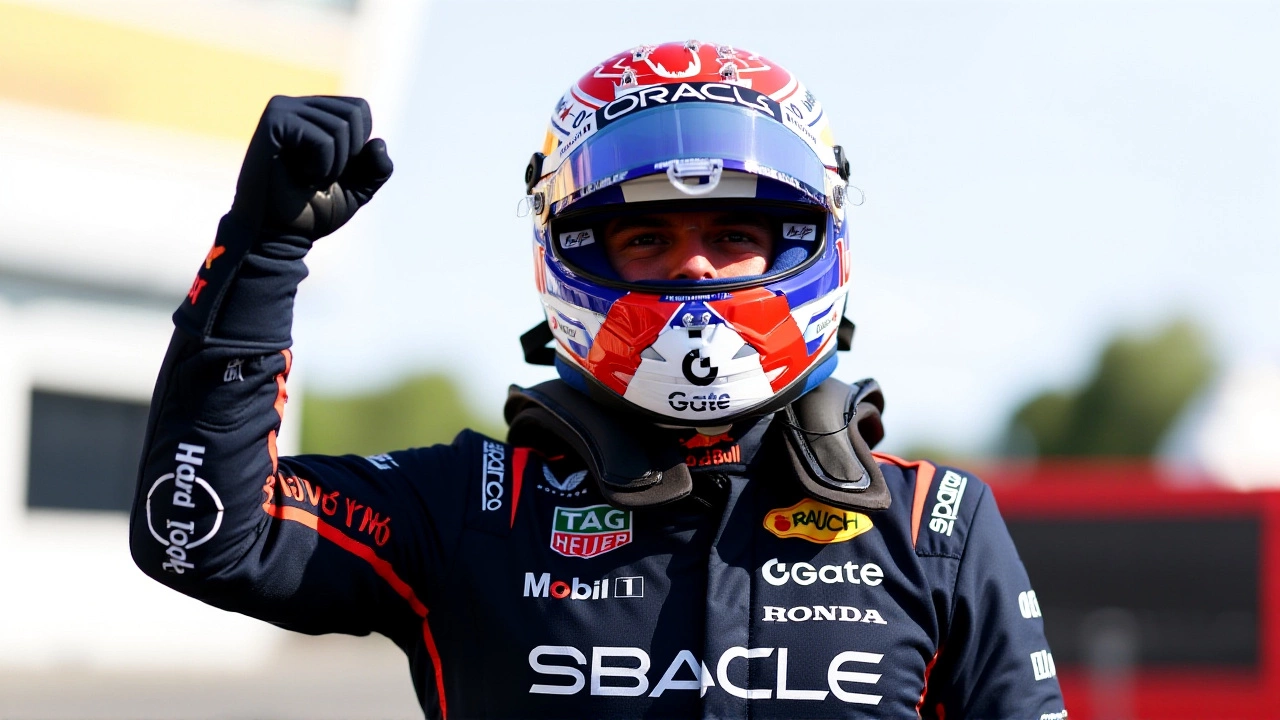On a crisp Saturday evening in Monza, Max Emelianovich Verstappen didn’t just win pole — he rewrote history. With a blistering lap of 1 minute 18.792 seconds on September 6, 2025, the Dutch driver claimed his 45th career Formula 1 pole position at the Autodromo Nazionale Monza, shattering the circuit’s all-time record and stealing the top spot from Lando Norris by a mere 0.077 seconds. The margin was so narrow, you could hear the tension in the Red Bull garage — and the silence that followed in the McLaren pit. Behind them, Oscar Piastri held third, 0.190 seconds back, while Charles Leclerc of Scuderia Ferrari rounded out the top four. The twist? Lewis Hamilton, who crossed the line fifth, was handed a five-place grid penalty, pushing his teammate George Russell up to fifth. It was a qualifying session that felt like a thriller written in tire smoke and engine screams.
The Temple of Speed Comes Alive
Monza isn’t just a racetrack — it’s a cathedral of speed. Located just 15 kilometers north of Milan, this 5.793-kilometer circuit has hosted the Italian Grand Prix since 1950, demanding raw engine power over downforce. With ambient temperatures at 24°C and track heat hitting 38°C, teams ran their lowest-downforce setups ever. The result? Lap times plummeted across the board. Verstappen’s 1:18.792 wasn’t just fast — it was 0.4 seconds quicker than last year’s pole at the same venue. And it came after Norris had briefly taken the top spot in Q3, a moment that sent the McLaren team into a frenzy. But then Verstappen, cool as ever, stepped on the throttle one final time. The ghost car comparison released by Formula 1 later showed Norris had the edge in Sector 1, but Verstappen’s exit from the Parabolica and acceleration out of the Lesmo curves were flawless. That’s where the race was won — not on straights, but on the delicate art of throttle application under extreme load.Penalties, Pitfalls, and the Mercedes Misstep
The drama didn’t stop at the front. Lewis Hamilton qualified fifth, but his penalty — for an unapproved gearbox change — was the talk of the paddock. More surprising was what happened to his teammate, George Russell. Russell had requested medium tires for his final run, expecting cooler track conditions. Instead, the team mistakenly fitted softs. He still managed a time good enough for sixth, but the error cost him a shot at the top five. "It’s not the first time we’ve messed up a tire call," admitted Mercedes team principal Toto Wolff in a post-session interview. "But when you’re fighting for every tenth, it’s the kind of mistake that haunts you." Meanwhile, Fernando Alonso, returning to form after a rough summer, qualified ninth — his best result since Spain — while rookie Kimi Antonelli stunned the field by making Q3 in his second-ever F1 weekend.Red Bull’s Quiet Comeback
McLaren entered the weekend with a 617-point lead in the Constructors’ Championship — 337 points ahead of Ferrari and 357 ahead of Red Bull. Their dominance had been absolute: 11 poles to Red Bull’s seven this season. But Monza exposed cracks. While Norris and Piastri were fast, their race pace wasn’t as dominant as expected. Verstappen’s pole was a signal — not just of speed, but of strategy. "They’ve been playing a long game," said former F1 engineer and current analyst David Coulthard. "Red Bull knew Monza would be their best shot. They’ve been conserving engines, saving tires, and waiting for the track to suit their car’s strengths. This wasn’t luck. It was calculated." And the data backed it up: Verstappen’s car was 0.3 seconds faster in the final sector than Norris’s, the exact area where Red Bull’s aerodynamic efficiency shines.
The Race That Followed
The pole didn’t just mean bragging rights — it meant victory. On Sunday, Verstappen led from the start, retaking the lead from Norris on Lap 4 after a brief overtake attempt through Curva Grande. The two traded fastest laps for the next 20 laps, but Verstappen’s tire management — a quiet masterpiece — allowed him to pull away in the final third. Norris finished second, Piastri third. It was Verstappen’s third win of the 2025 season, but more importantly, it cut McLaren’s championship lead by 18 points. With the Drivers’ Championship now led by Piastri (324 points), followed by Norris (293), and Verstappen (230), the title fight is alive — and hotter than ever.What’s Next? Singapore Beckons
The next race, the Singapore Grand PrixMarina Bay Street Circuit, is a world away from Monza’s high-speed purity. The tight, humid, night-time street circuit favors mechanical grip and braking stability — areas where McLaren still holds an edge. But if Verstappen can carry the momentum from Monza, the title race could shift dramatically. Red Bull’s engineers are already testing new front-wing configurations for Singapore, while McLaren is quietly reviewing their tire strategy after two consecutive weekends where their soft compounds degraded faster than expected.
Behind the Numbers
- Verstappen’s 45th pole breaks the previous record held by Lewis Hamilton (44).- The 0.077-second gap between Verstappen and Norris is the closest pole margin at Monza since 2018.
- McLaren has 11 poles this season; Red Bull has 8.
- Ferrari’s 280 points in the Constructors’ Championship are their highest since 2019.
- The 2025 Italian GP was Round 14 of 24 in the championship.
Frequently Asked Questions
How did Verstappen’s pole time compare to previous records at Monza?
Verstappen’s 1:18.792 shattered the previous Monza lap record of 1:19.207 set by Charles Leclerc in 2022. It was also 0.4 seconds faster than the 2024 pole time, making it the fastest ever recorded at the circuit. The previous fastest qualifying lap in F1 history was 1:18.892 by Hamilton at Silverstone in 2020 — meaning Verstappen broke the overall record, not just the track record.
Why did Lewis Hamilton get a grid penalty?
Hamilton received a five-place grid drop for replacing a gearbox component outside the allowed usage window. While the team claimed it was due to a minor damage incident in FP3, FIA records show the part had completed 4,872 kilometers — exceeding the 3,500-kilometer limit. This penalty promoted George Russell into the top five and gave Verstappen a slightly cleaner path to victory on race day.
What does this mean for the Drivers’ Championship?
Before Monza, McLaren’s Norris and Piastri held a combined 617-point lead over Verstappen. After his win, Verstappen closed the gap to just 94 points behind Piastri. With only 10 races left and 25 points for a win, the title is now a three-way battle. Verstappen’s consistency — eight podiums in the last 10 races — makes him the most dangerous challenger, even if he’s third in points.
Why is McLaren still leading the Constructors’ Championship despite losing pole and the race?
McLaren’s dominance comes from consistency, not just wins. Norris and Piastri have finished in the top three in 12 of the first 14 races. Even when they don’t win, they score heavily. Red Bull, by contrast, has had three DNFs this season. McLaren’s 617 points are nearly double Ferrari’s 280 — they’ve turned reliability into a championship weapon.
Can Red Bull catch McLaren in the Constructors’ Championship?
It’s mathematically possible, but unlikely. McLaren leads by 337 points. To catch them, Red Bull would need to win every remaining race and have McLaren score zero points — a near-impossible scenario. But if Red Bull keeps winning and McLaren has mechanical failures, they could force a dramatic late-season collapse. The real question isn’t whether they’ll catch them — it’s whether they can make the title fight about more than just one team.
What’s the significance of Verstappen’s 45th pole?
It moves Verstappen past Lewis Hamilton into sole possession of second place on the all-time pole list, behind only Michael Schumacher’s 68. But more than the number, it’s the context: he’s done it in fewer races (171 vs. Hamilton’s 313), at a time when F1 cars are more complex and aerodynamically sensitive. It’s not just a stat — it’s proof of his adaptability, precision, and nerve under pressure.

Write a comment